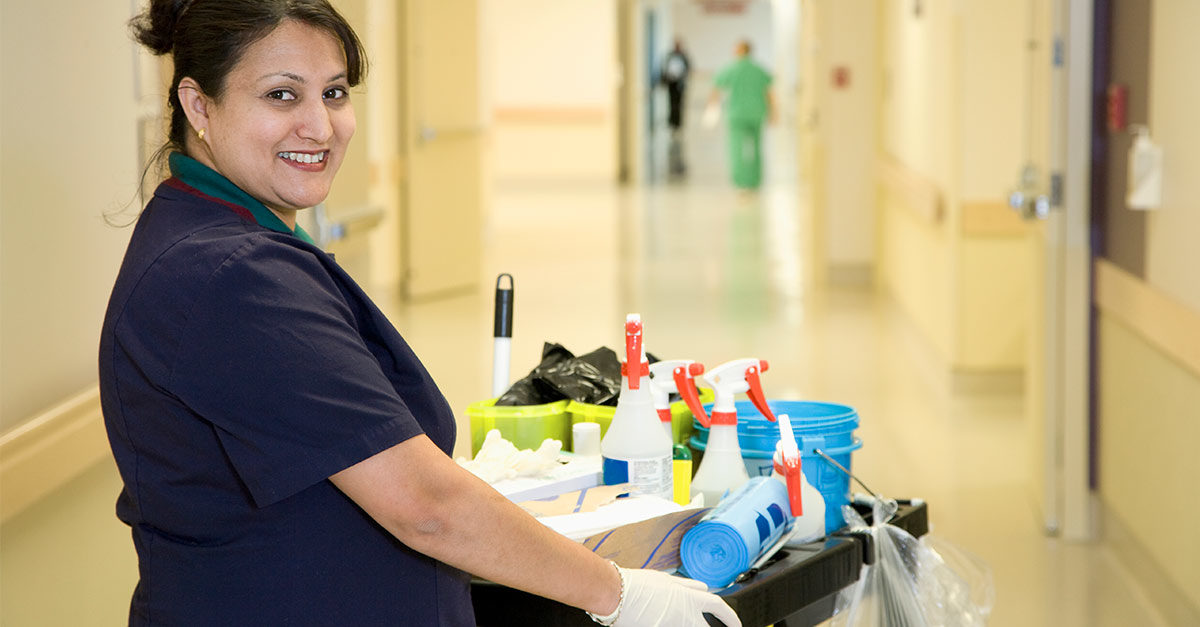We are in an era where proper cleaning has become an essential defense against serious, even life-threatening infections. Proper cleaning is clearly associated with preventing the spread of many common infections, such as cold viruses, which are transmitted through direct contact with contaminated surfaces. Meanwhile, allergens that trigger asthma as well as other allergic reactions can quickly accumulate if cleaning is not sufficient. In short, proper cleaning creates a healthier environment that reduces the risk of common, less serious diseases. Yet other times, proper cleaning may be life saving.
In the past, the connection between cleaning and health has been most obvious in hospitals and health care facilities. Now, however, with the arrival of methicillin-resistant Staphylococcus aureus (MRSA) and other life-threatening infections, the need for cleaning is becoming increasingly crucial for all the areas where we live, work, and play.
The Birth of MRSA
MRSA is the abbreviation for an emerging infection that, while not quite a “superbug,” has the potential to cause devastating infections and has even morphed into a particularly dangerous strain, USA 300, which is transmitted by skin-to-skin contact and is resistant to multiple antibiotics, and may morph again in the future.
Briefly, MRSA is a variant of staph which has acquired resistance to the antibiotic methicillin. How did this happen?
Bacteria acquire resistance when an antibiotic is given and before long, the resistant strains become dominant. The infection caused by the resistant bacteria crosses over to otherwise healthy people. Because the “emerging” infectious disease is immune to the antibiotics used to treat its predecessor, it becomes a public health problem and new antibiotics are urgently needed to keep up with them.
In most cases, MRSA is at the stage where it can still be treated, but it is clearly a serious public health problem as are other serious infections both known and yet to develop.
Why Is MRSA Different
Staph infections with the virility of MRSA have picked up some nasty habits or, more accurately, bad genes. For starters, MRSA is a more aggressive version of staph. This can prove especially troublesome for patients with lowered immune systems, such as those receiving cancer chemotherapy, who can pick up MRSA far too easily in health care settings. Worse, MRSA and other staph can take many forms, often making them hard to recognize and treat.
Healthy people usually get it as a skin infection, in the form of an abscess, pimple, or boil on the skin and it initially resembles and is often mistaken for a spider bite. The infection can be treated with different antibiotics if it is recognized, but treatment often takes longer.
How MRSA Travels
In hospitals, MRSA and other staph are often present in fixtures and equipment and can be carried in the noses and hands of hospital personnel. Outside the hospital, it is thought MRSA is spread mostly by skin contact or by intravenous drug users. It can also be carried on people’s hands, in their noses, and on contaminated objects or surfaces. Skin-to-skin or skin-surface-skin contact transmits the bacteria, often through a cut or abrasion on the skin. Right now, the disease is most common in medical settings and places where people live closely together or have physical contact, such as athletes, military recruits, school children, retirement centers, cruise ships, and prisoners. To date, it is not technically considered a sexually transmitted disease—but only because it can be transmitted through physical contact with an infected person or surface of any sort.
Health Care Lessons
It is clear that staph can live for a while on floors, equipment, surfaces, and beds in everywhere from health care and daycare to office buildings and senior living environments. Cleaning is, therefore, a vital component to stopping the transmission of MRSA. But what are the best practices to prevent its spread, and do we need to clean every building as if it were a hospital? Fortunately, not every building needs cleaning to the same level as a hospital, but we can learn a lot from the experience of hospitals as they are the worst-case scenarios. Hospitals have shown us that conventional disinfection can work against MRSA, but the cleaning has to be thorough and accompanied by decontamination of the patient and shared medical equipment, avoiding sharing towels and other personal items, and frequent hand-washing.
The major problem in hospitals appears to be recontamination, which has been amply demonstrated. Radiators, shared medical equipment, furniture, door handles, televisions, floors and other flat surfaces, ventilation duct grills, and beds were all found to be contaminated within the hospital setting. Outbreaks of MRSA have been controlled in hospitals and day care settings for special-needs children by thorough cleaning, vacuuming (rather than mopping, which was found to be ineffective), and meticulous attention to hard-to-clean equipment, including the nurse-call button.
In non health care settings, the best possible guard against MRSA is to enforce frequent hand-washing wherever possible and insist on decontamination of visitors to any MRSA contaminated envirnments.
Best MRSA-Fighting Practices
Below are the best cleaning practices to help prevent the spread of MRSA and other staph bacteria.
• Cleaning and disinfection of floors, vacuuming dust with HEPA-or micron filter-fitted vacuums, careful cleaning, disinfection of shared equipment, including computer peripherals, and attention to doorknobs are practices that will reduce the risk of transmitting MRSA.
• Cleaning and decontamination of bedding and clothing may require washing at 104 to 140 degree F (40 to 60 degrees C) using a disinfecting agent.
• Soap and water cleaning is not adequate for control of bacterial contamination by pathogens because the process removes bacteria mechanically, and so reduces the number of bacteria rather than killing it and preventing replication. Chemical disinfection is required.
• Cleaning cloths are always a worry because they might spread bacteria when they are reused.
• Among the various disinfectants that could be used for direct application, products containing hypochlorite (bleach), phenolic, and quaternary ammonium compounds were effective against MRSA.
• Careful attention should be paid to cleaning and disinfection of gym mats, exercise machines, showers, and floor surfaces between uses that may involve skin contact.
• Spray bottles with disinfectant that can be used for convenience to spray and wipe-down should be sufficient for solid surfaces; reusable coverings may be needed for some purposes.
• Soap should be provided in dispensers, preferably touch-free, rather than shared bars of soap, and hands should be dried by individual and disposable towels or by air dryer.
• Frequent hand-washing with soap and hot water or hand sanitizing with an instant, alcohol-based hand sanitizer when washing facilities are not available or convenient, should be practiced and encouraged in all common public areas, such as workplaces, schools, and fitness centers.
• Facilities that offer personal services, such as steam rooms, saunas, hot tubs, swimming pools, immersion tanks, and washing machines, need to be allowed to dry and also disinfected periodically.
• Protection of cleaning personnel is also important; hand-washing with running water, alcohol-based hand rubs, and gloves, which must be washed or disposed of regularly, are important to protect the worker as well as to break any possible chain of transmission from cleaning and maintenance activities.
This article was revised and updated May 18, 2018, from its original post date of September 19, 2010.



